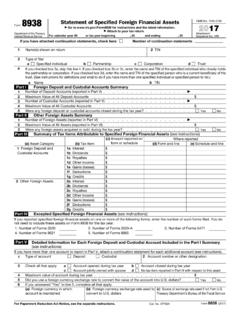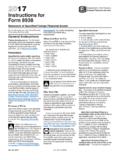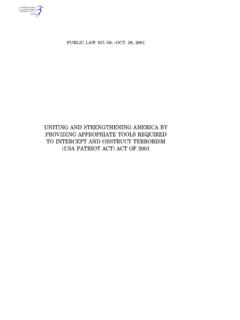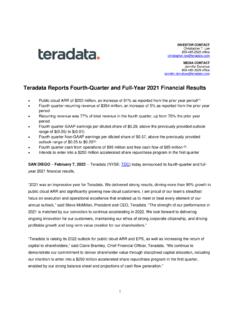Transcription of Ind AS 32 and Ind AS 109 - Financial Instruments ...
1 Ind AS 32 and Ind AS 109 - Financial Instruments Classification, recognition and measurementJune 2015 Executive summaryStandards dealing with Financial Instruments under Ind ASFinancial instrumentsPrinciples of liability/equity classificationCompound instrumentsTreatment of interest, dividends, gains and losses and other itemsFinancial assets and Financial liabilities - initial recognitionFinancial assets - classification and subsequent measurementFinancial liabilities - classification and subsequent measurementForeign exchange gains and losses on Financial assets and Financial liabilitiesTransitional provisions with respect to the classification and measurement of Financial instrumentsImpact of Ind AS 32 and Ind AS 109040506071318202237404142 Contents2In a nutshell Comprehensive standards on Financial Instruments issued under the Companies (Indian Accounting Standards) Rules, 2015.
2 Financial Instruments to be classified as per substance rather than legal form. All Financial Instruments are initially measured at fair value plus or minus, in the case of a Financial asset or Financial liability not at fair value through profit or loss (FVTPL), transaction costs. Subsequent to initial recognition, Financial assets should be measured at amortised cost, fair value through other comprehensive income (FVTOCI) or FVTPL. Amortised cost classification is permissible for debt Instruments only if they meet both the business model test and the contractual cash flow characteristics test. All equity investments in the scope of Ind AS 109 are to be measured at fair value in the statement of Financial position, with value changes recognised in profit or loss, except for those equity investments for which the entity has irrevocably elected to present value changes in other comprehensive income (OCI).
3 For Financial liabilities, two measurement categories exist: FVTPL and amortised cost. Financial liabilities held for trading are measured at FVTPL, and all other Financial liabilities are measured at amortised cost unless the fair value option is applied. For Financial assets, reclassification is required between FVTPL, FVTOCI and amortised cost, if and only if the entity's business model objective for its Financial assets changes so its previous model assessment would no longer apply. Classification must be done prospectively. No reclassification allowed for equity investments measured at FVTOCI, or where the fair value option has been exercised for Financial assets.
4 Reclassifications of Financial liabilities in and out of FVTPL category are prohibited. Ind AS 32 and Ind AS 109 - Financial Instruments : Classification, recognition and measurement 3 Currently under Indian GAAP, there is no comprehensive literature for accounting for Financial Instruments . While AS 13, Accounting for Investments deals with the accounting for investments in the Financial statements and related disclosure requirements, it does not cover the classification and measurement of Financial liabilities. While some other standards cover some other aspects of Financial Instruments , AS 11 The Effects of Changes in foreign Exchange Rates covers certain forward exchange contracts, the requirements in the Indian standards were never as robust as in the International the issuance of the Companies (Indian Accounting Standards) Rules, 2015, the position now changes as all specified companies (other than banks, non-banking Financial companies and insurance companies) will now have to follow the Indian Accounting Standards (Ind AS).
5 Ind AS contains comprehensive standards that deal with Financial Instruments and introduce concepts that are relatively new in India. The distinction between equity and liability itself will now need careful consideration with the substance rather than legal form driving the classification. It is expected that a lot more Instruments may now get reclassified as a Financial liability from equity. The potential change in classification of preference shares and certain other Instruments from equity and the consequential recognition of dividends paid on such Instruments as interest cost may impact Financial ratios. The impact of this change on debt covenants, if any, should be Indian GAAP, the use of fair value is limited to current investments which are required to be recognised at the lower of cost and fair value.
6 Long term investments are always recognised at cost less permanent diminution in value. Under Ind AS, an entity will be required to classify Financial assets as subsequently measured at either amortised cost or fair value on the basis of both the entity s business model for managing the Financial assets and the contractual cash flow characteristics of the Financial asset . A reclassification is required when there is a change in the business model. Therefore, a substantial amount of judgment will now be required to determine the correct classification. There will also be a need to track historical data to ascertain whether the business model test is met.
7 Systems and processes associated with gathering historical information, information relating to fair values etc. may need to be modified to support the capture of additional data elements that may not currently be supported by legacy equity investments within the scope of Ind AS 109 are to be measured on the balance sheet at fair value with the default recognition of gains and losses in profit or loss which could lead to income statement volatility. Only if the equity investment is not held for trading can an irrevocable election be made at initial recognition to measure it at FVTOCI with only dividend income recognised in profit or loss.
8 The valuations market in India is not mature and obtaining the fair value of unquoted Instruments may also prove to be a AS 109 does not require an assessment or separation of embedded derivatives for Financial assets. Instead if there are exotic features, the instrument is likely to fail the contractual cash flow characteristics test and be measured at FVTPL in its entirety (by virtue of it not qualifying for amortised cost accounting or failing the FVTOCI category for debt Instruments ). For Financial liabilities which are usually recognised at par value under Indian GAAP, there will henceforth be two measurement categories: FVTPL and amortised cost.
9 Financial liabilities held for trading will be measured at FVTPL, and all other Financial liabilities will be measured at amortised cost unless the fair value option is changes can impact organisations in the area of key performance indicators, product portfolio, risk management, budgeting and planning, and reporting and regulatory summary14 Under Ind AS, three Standards deal with accounting for Financial Instruments . Ind AS 32 Financial Instruments : Presentation deals with the presentation and classification of Financial Instruments as Financial liabilities or equity and sets out the requirements regarding offset of Financial assets and Financial liabilities in the balance sheet.
10 Ind AS 107 Financial Instruments : Disclosures sets out the disclosures required in respect of Financial Instruments . Ind AS 109 Financial Instruments contains guidance on the recognition, derecognition, classification and measurement of Financial Instruments , including impairment and hedge this publication on Ind AS 32 and Ind AS 109, we deal with the classification, recognition and measurement aspects of Financial Instruments . At the outset, it may be noted that fair value of Financial Instruments should be determined in accordance with the principles enunciated in Ind AS 113 Fair Value dealing with Financial Instruments under Ind AS2 Ind AS 32 and Ind AS 109 - Financial Instruments : Classification, recognition and measurement 5 The definition of a Financial instrument is broad.

















